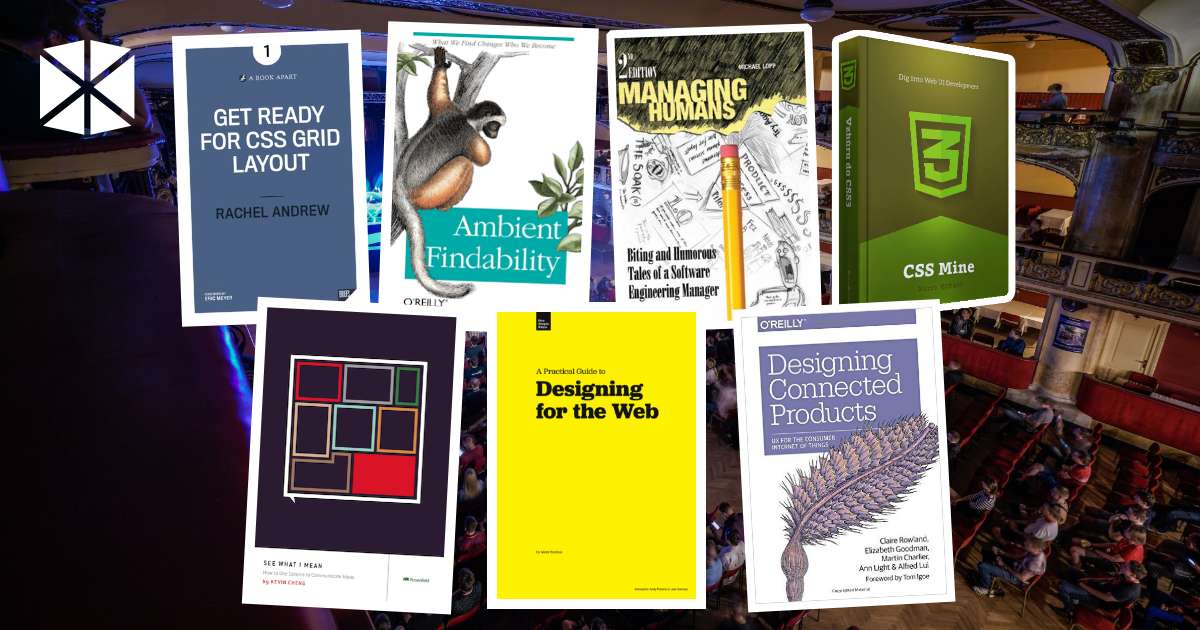
This was originally posted on medium.com.
Need something to read while you’re on the beach or in the garden? We recommend these seven books written by speakers from WebExpo 2016.
1. Get Ready For CSS Grid Layout, Rachel Andrew
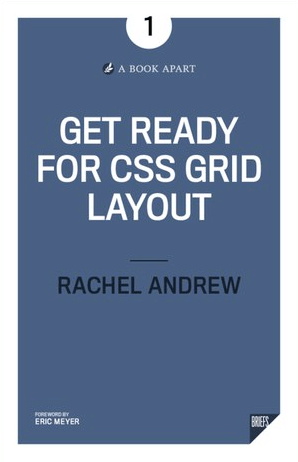 Working with CSS and layout elements on the page? Ever asked yourself how something as simple as a grid can have so many different variations and why no one has tried to standardize them? This is the precise question that Rachel and her colleagues at the CSS Working Group are working on answering. In her book, Get Ready for CSS Grid Layout, Rachel outlines in approximately sixty pages the basic principles which (we hope) will soon become the layout of the modern web. At the moment, it’s still just an experimental project, but one which will one day make building elements as easy as using InDesign. Rachel also maintains the website Grid By Example, which is a collection of basic usage examples. On a side note: this style of graphic design, based on strict as well as freer arrangements in the grid, became known as swiss style due to its promotion by Swiss designers. Perhaps, we can expect a similar refresh for nonuniform cascading style sheets and websites in general.
Working with CSS and layout elements on the page? Ever asked yourself how something as simple as a grid can have so many different variations and why no one has tried to standardize them? This is the precise question that Rachel and her colleagues at the CSS Working Group are working on answering. In her book, Get Ready for CSS Grid Layout, Rachel outlines in approximately sixty pages the basic principles which (we hope) will soon become the layout of the modern web. At the moment, it’s still just an experimental project, but one which will one day make building elements as easy as using InDesign. Rachel also maintains the website Grid By Example, which is a collection of basic usage examples. On a side note: this style of graphic design, based on strict as well as freer arrangements in the grid, became known as swiss style due to its promotion by Swiss designers. Perhaps, we can expect a similar refresh for nonuniform cascading style sheets and websites in general.
Rachel’s talk: The right layout tool for the job, Saturday 24.9., Lucerna Great Hall
2. Ambient Findability, Peter Morville
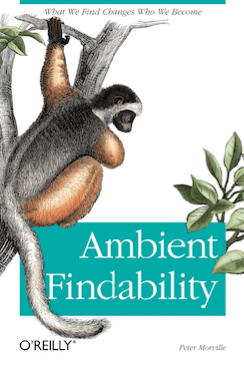 Ever heard of “information overload”? Some say it is one of the biggest challenges we face in today’s media. This holds doubly true on the web since it can be used to spread a large quantity of both good and bad news — and very quickly. Others see things in a different light: we live in a time that allows us to effectively filter out waste and get the information we need. Peter Morville is among the founders of the field of information architecture. In his book, Ambient Findability, he outlines the principles of creating a good environment for the “searchability” of information from the perspective of both information architects and searchers. According to Peter, our fear of losing our bearings has led to the creation of maps, drawings, dictionary, libraries, and the Internet. Prepare yourself for an inspiring view of human culture as a search process as well as practical examples and demonstrations on ways to improve IA, UX and your own work with information.
Ever heard of “information overload”? Some say it is one of the biggest challenges we face in today’s media. This holds doubly true on the web since it can be used to spread a large quantity of both good and bad news — and very quickly. Others see things in a different light: we live in a time that allows us to effectively filter out waste and get the information we need. Peter Morville is among the founders of the field of information architecture. In his book, Ambient Findability, he outlines the principles of creating a good environment for the “searchability” of information from the perspective of both information architects and searchers. According to Peter, our fear of losing our bearings has led to the creation of maps, drawings, dictionary, libraries, and the Internet. Prepare yourself for an inspiring view of human culture as a search process as well as practical examples and demonstrations on ways to improve IA, UX and your own work with information.
Peter’s Talk: The Architecture of Understanding, Friday 23. 9., Lucerna Great Hall.
3. Managing Humans, Michael Lopp
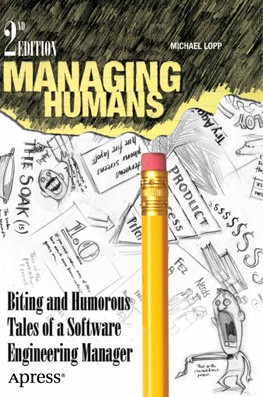 There was once a programmer who noticed that when developing software even the most brilliant people are capable of making big mistakes. And then, he realized there were only two career paths for him: learn how to master bits and code — or learn how to work with people. In his opinion, the majority of managers were sadly better at the former, so he chose the second path and later, even wrote a book about it for others: Managing Humans. He’s sure to win you over with his humor and sincere brevity. Michael has been writing about his experiences as a manager of development teams on his blog Rands in Repose since 2002. Managing Humans contains a selection from his posts and a few extra things. We also highly recommend checking out these posts from his blog: Version 1.0, Your People, The Nerd Handbook, What To Do When You’re Screwed,Innovation is a fight, and Design Primer for Engineers.
There was once a programmer who noticed that when developing software even the most brilliant people are capable of making big mistakes. And then, he realized there were only two career paths for him: learn how to master bits and code — or learn how to work with people. In his opinion, the majority of managers were sadly better at the former, so he chose the second path and later, even wrote a book about it for others: Managing Humans. He’s sure to win you over with his humor and sincere brevity. Michael has been writing about his experiences as a manager of development teams on his blog Rands in Repose since 2002. Managing Humans contains a selection from his posts and a few extra things. We also highly recommend checking out these posts from his blog: Version 1.0, Your People, The Nerd Handbook, What To Do When You’re Screwed,Innovation is a fight, and Design Primer for Engineers.
Michael’s Talk: Stables and volatiles — how to get Different types of humans to work together, Saturday 24. 9, Lucerna Great Hall
4. CSS Mine, Martin Michálek
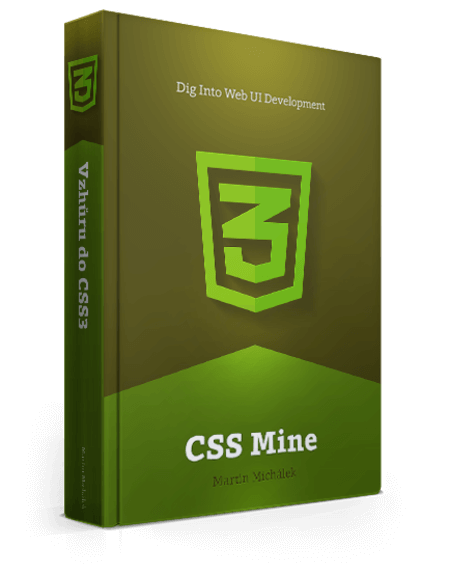 Imagine that you you need to solve the horizontal alignment of a title with a CSS element, and you can’t look it up on Stack Overflow! Sounds like a piece of cake, right? It’s not as easy as you think. Martin Michálek has put together a very useful e-guide for all cases: CSS Mine. Thanks to him, you’ll be able to solve a lot of problems without an internet connection or online forums. Even though it’s mainly meant for beginners and more advanced, it also covers topics like the flexbox. Don’t forget to take a look at the clear diagrams, illustrations, and online examples with pieces of code. One opinion from a recent review: “Although it might seem that a large portion of this ebook could be found elsewhere, you’d be hard-pressed to find a more complete overview for studying the most current practices in CSS3.”
Imagine that you you need to solve the horizontal alignment of a title with a CSS element, and you can’t look it up on Stack Overflow! Sounds like a piece of cake, right? It’s not as easy as you think. Martin Michálek has put together a very useful e-guide for all cases: CSS Mine. Thanks to him, you’ll be able to solve a lot of problems without an internet connection or online forums. Even though it’s mainly meant for beginners and more advanced, it also covers topics like the flexbox. Don’t forget to take a look at the clear diagrams, illustrations, and online examples with pieces of code. One opinion from a recent review: “Although it might seem that a large portion of this ebook could be found elsewhere, you’d be hard-pressed to find a more complete overview for studying the most current practices in CSS3.”
Martin’s Talk: 10 Practical CSS3 and SVG Solutions, Friday 23. 9, Kino Lucerna
5. See What I Mean, Kevin Cheng
 Do you know what comics and storyboards have in common? In addition to a combination of images and words as storylines, there is also a number approaches that you can use without the need for professional knowledge of drawing or the mechanics of narrative. Kevin Cheng’s book See What I Mean outlines practical methods and theory in a somewhat unusual presentation: each chapter, in addition to text, also contains a summary in the form of a comic. Among the pioneers of drawing for software designers are Scott McCloud’s Understanding Comics and The Google Chrome Comic. Understandably, Kevin references McCloud as an interesting resource for taking your storyboards to the next level. You can also use drawing outside of UX — explaining a product when you pitch investors, development, and more. Here’s why you shouldn’t be afraid to try it: 1. You don’t need Photoshop, you just need a pen and paper; 2. If you can draw a comma and a circle, that’s more than enough; 3. Cartoons can help you visualize the qualities of your products better; 4. The book has a chapter on how to convince your clients and colleagues about the effectiveness of using comics.
Do you know what comics and storyboards have in common? In addition to a combination of images and words as storylines, there is also a number approaches that you can use without the need for professional knowledge of drawing or the mechanics of narrative. Kevin Cheng’s book See What I Mean outlines practical methods and theory in a somewhat unusual presentation: each chapter, in addition to text, also contains a summary in the form of a comic. Among the pioneers of drawing for software designers are Scott McCloud’s Understanding Comics and The Google Chrome Comic. Understandably, Kevin references McCloud as an interesting resource for taking your storyboards to the next level. You can also use drawing outside of UX — explaining a product when you pitch investors, development, and more. Here’s why you shouldn’t be afraid to try it: 1. You don’t need Photoshop, you just need a pen and paper; 2. If you can draw a comma and a circle, that’s more than enough; 3. Cartoons can help you visualize the qualities of your products better; 4. The book has a chapter on how to convince your clients and colleagues about the effectiveness of using comics.
Kevin’s Talk: TBA, Saturday 24. 9., Lucerna Great Hall
6. Designing For The Web, Mark Boulton
Cooking up a design for the web requires a broad set of skills. In Designing for the Web Mark goes over everything a good web designer should know. From “classic” skills (creating layouts, color, typography) to managing projects and job search. The book is available to download for free. We also recommend his chapter on creating and editing assignments (The Brief) to anyone, even those of us who already have a job. It’s also not just a book for designers. As one review on Amazon said: “Designing for the Web won’t teach you anything about HTML5, CSS3 or anything else the cool kids are talking about these days. Quite the opposite. And this is why you should read it.” FYI: his book is free to download.
Mark’s Talk: Design Systems in Difficult Places, Friday 23. 9., Lucerna Great Hall
7. Designing Connected Products: Martin Charlier, Claire Rowland, Elizabeth Goodman, Ann Light, Alfred Lui
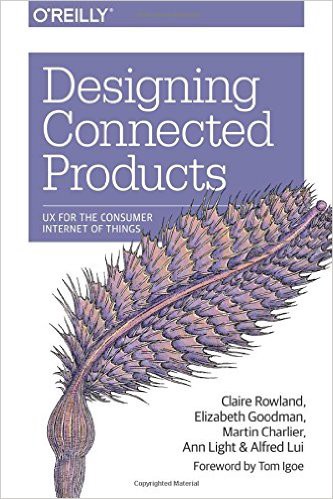 The Internet of Things will change the nature of the products we work with as designers. Things are interconnected just like our experiences and interactions with different devices, different locations, and types of interfaces. Business models are beginning to lean towards service design, but setting the values is more difficult. To make matters worse, the technical complexity of the systems in which we operate is getting more complicated. Martin Charlier is one of the co-authors of last year’s hit Designing Connected Products — one of the first books to offer a practical view of UX design for new types of products. One of the first real examples of IoT was Nike+ and its products. Director of Nike+ Design Ben Fullerton says of the book: “The authors do a fantastic job of not only exposing the complexities of a future pervaded by connected things, but suggesting exactly how we can consciously go about preventing that complexity from overwhelming us. This book will be an essential reference for designers as they come to grips with creating these new type of things that will live throughout our lives.”
The Internet of Things will change the nature of the products we work with as designers. Things are interconnected just like our experiences and interactions with different devices, different locations, and types of interfaces. Business models are beginning to lean towards service design, but setting the values is more difficult. To make matters worse, the technical complexity of the systems in which we operate is getting more complicated. Martin Charlier is one of the co-authors of last year’s hit Designing Connected Products — one of the first books to offer a practical view of UX design for new types of products. One of the first real examples of IoT was Nike+ and its products. Director of Nike+ Design Ben Fullerton says of the book: “The authors do a fantastic job of not only exposing the complexities of a future pervaded by connected things, but suggesting exactly how we can consciously go about preventing that complexity from overwhelming us. This book will be an essential reference for designers as they come to grips with creating these new type of things that will live throughout our lives.”
Martin’s Talk: Designing for connected products, Friday 23. 9., Lucerna Great Hall

